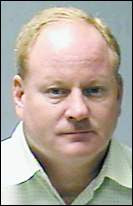Friday, December 30, 2016
Steve Ray Murphy: The Forgotten Felon
Steve Ray Murphy was 22 years-old when he and his best friend began their partnership in crime in 1977. Perhaps you can't place Murphy? Perhaps his partner's name will refresh your memory: Trent O'Neal Townsend. The two Lauderdale County men were misfits from childhood; they found each other when the younger Townsend needed help escaping from a foster home and formed a synergistic partnership where 1+1=3, a partnership sparking fear in many, even some law enforcement personnel.
The duo's crimes may have reached a peak in April 1983. It was Gregory Edward Ayer's first night on the job at the Red Ace Service Station in Tuscumbia when a customer found his lifeless body. Murphy and Townsend soon became suspects in the robbery turned murder and were later arrested and tried for the capital crime.
In the interim, both Murphy and Townsend were tried for other crimes and sentenced to life in prison under the habitual offender act. For whatever reason, both men were sent to St. Clair Prison where they continued their friendship and hatched an escape plot. Escape was nothing new to Townsend who already had one such charge. The convicts flawlessly executed their plan via a drain pipe and were soon free men. It wasn't to last.
Murphy was later captured in Kansas, but the still-free Townsend helped engineer his escape. Both were soon on their way back to the Shoals where they initiated a crime spree in order to survive.
In 1977, Murphy had worked at the Pepsi Cola Bottling Plant on Highway 43 in Tuscumbia; he knew that a Wells Fargo truck visited the plant daily, and so a plan was hatched. Shortly after ten in the morning on that late July day, a woman drove up to the plant, and two men exited the vehicle. Both men entered the plant and immediately announced they were there to commit armed robbery. Murphy further announced he knew the armored truck would soon arrive since he had previously worked there.
Both men escaped on foot and allegedly ran across the highway to a waiting vehicle. Their freedom was short lived, and after a few days the pair was captured and returned to jail, having added a laundry list of new charges to their resume'. A trial for Ayers' murder now awaited them.
A Colbert County jury convicted Murphy, but couldn't reach a verdict in Townsend's case, and the attorney general's office decided not to pursue the charges since the career criminal was already serving a life sentence. There has never been total justice for Gregory Edward Ayers' family--at least officially.
As his murder trial dragged on, both Townsend's younger bother and maternal grandfather committed suicide. After being returned to prison, Townsend was the victim of a stabbing in 1988 and won a lawsuit against the state; however, the $75,000.00 award in the case was later stolen from Townsend's mother. It was obviously a pyrrhic victory, and the Lauderdale County man remained incarcerated.
Eight years to the day after Ayers' murder, Trent Townsend was found dead in his cell at the West Jefferson Correctional Facility near Birmingham. Authorities claimed Townsend hanged himself using rope from his officially issued laundry bag. His partner in crime Steve Murphy thought otherwise.
After Townsend's alleged suicide, Steve Ray Murphy again denied their involvement in the fatal Red Ace robbery, stating he had nothing to gain by refusing to take responsibility. He also commented that he knew Trent better than anyone, loved Trent better than he loved his own wife, and Townsend would never have killed himself.
Murphy has continued to deny the Red Ace murder for 25 years. Barred from parole and serving a 999 year sentence, the Lauderdale County man is housed in Holman Prison where he's listed as a medium security prisoner. His once luxurious hair has thinned, and he now wears spectacles. He receives few visitors...and he continues to maintain his innocence in the death of Gregory Edward Ayers.
Thursday, September 1, 2016
Bear Footin'
Warning: This punny tale of grizzly crime may not be suitable for the humor impaired...
Summer had just breathed its dying breath in the year of ’08 (that’s 2008) as we begin our tale of lurid crime…or should that be tail? It was almost midnight on Saturday, September 20th, when a young man called his dog in for the night. In the dog’s mouth appeared to be a small foot…a small human foot.
The young man called his father who called police to their Hester Heights home just west of Highway 43 in Russellville. Police Chief Chris Hargett is known to take his job seriously, and not even a pressing meeting at the Russellville Housing Authority could have kept him from personally investigating this strange canine find.
Hargett pronounced it a small, bare foot, probably belonging to a young child. He immediately took the foot to the Russellville Hospital Emergency Department where the physician on duty similarly pronounced the dog’s booty to be a recently severed human foot.
The foot was then routed to a Russellville orthopedic surgeon who concurred that the remains were human and belonged to a small child. Chris Hargett had his work cut out for him; no children had been reported missing in the area, and the medical personnel who inspected the foot averred that it was highly unlikely any child could have survived such an amputation without immediate medical intervention.
On Monday, cadaver dogs were brought in from HEMSI in Huntsville and the North Alabama Search Dog Association in Madison. They combed the entire area around Circle Drive and Wilson Boulevard, but despite their best efforts, no other remains were found. Was the Hester Heights foot destined for an unmarked shoe box? In the interim, the foot was sent to the Alabama Department of Forensic Sciences in hopes of determining race and gender. Hargett proclaimed, “We pretty much have to think the worst.”
Sadly, many suspected the foot somehow belonged to Jennifer Hampton, a small, young Florence woman who had gone missing from a Knoxville, Tennessee, motel room. Had she been taken captive and brought back to Alabama for some diabolical reason?
Meanwhile, the forensics lab had failed to answer the question of the foot’s humanity, and Hargett had the grisly find sent to UAB in hopes of any definitive information. Just as Russellville’s answer to Inspector Clouseau was about to call a news conference to proclaim there was no news on the case, the news in fact arrived. The foot belonged to a bear cub.
No official word was ever offered as to where the severed foot was interred…or as to what ridicule a certain Russellville orthopedic surgeon most certainly had to endure.
Wednesday, July 27, 2016
Annie Ruth Dennis: Beauty, Nurse, Murderess
At 73 years of age, Hampton Smiley was a long-time Florence minister. Working with the St. James Missionary Baptist Church in Florence, Smiley and his wife Arcadia, 72, were considered pillars of both the community and the church where Arcadia (known as Ann) played the organ for many years. Then Ann Smiley suffered a stroke, and the lives of the Florence couple changed forever.
*****
Annie Ruth Dennis grew up across the street from the Smiley home and was a graduate of Burrell High School, an all black institution once located in West Florence. Beautiful, as well as intelligent and witty, she was going to go somewhere and be someone. Initially, Annie worked as a meat cutter for Wilson Foods, but her drive and intelligence led her to become a Licensed Practical Nurse. Annie worked at Shoals Hospital and took private patients. Higher pay in the Memphis area led Annie to seek employment there, and she began to divide her time between Memphis and her Lucas Street home in Florence.
At some point, Annie married Robert O. Dennis, but the marriage proved less than what Annie had hoped for. In 1977, Robert Dennis, 40, was found shot dead in the back seat of his car, hands bound together, his wallet missing. Memphis police stated they had no leads, although the spouse is usually a strong suspect in most murder cases.
Annie continued to divide her time between Florence and Memphis which offered higher pay. Since she was still taking private patients in the Shoals and attended St. James, Annie easily secured the job of taking care of Ann Smiley after her stroke. Ann’s initial prognosis wasn’t good; Mrs. Smiley was probably not going to recover.
The Smileys’ friends at first were delighted at how Annie took over when she worked in the minister’s Beale Street home, but some later became concerned that the practical nurse was entirely too close to Hampton Smiley. They viewed it as a very unhealthy situation.
Annie told friends that Smiley planned to take her on a trip to a ministerial conference, something she greatly looked forward to; however, nothing in life is ever certain, and Ann Smiley began to recover. The minister would be taking his wife on the long anticipated trip—not Annie.
During this time period, Annie Dennis had secured a new job in Memphis. She began work at St. Jude’s and found a room nearby the children’s hospital where she lived during the week, returning on weekends to tend to her own home and the Smiley family. The Memphis woman with whom Annie lived told authorities that while she saw little of the nurse due to her schedule, she considered Annie to be family and trusted her completely.
*****
The third Sunday of April 1984 was Easter, and the St. James congregation gave Hampton Smiley a present of $1,000.00 in cash in honor of his completing 28 years of service to the church. Late on Sunday, April 23rd, Annie Dennis checked on the Smileys before driving back to Memphis where she worked the night shift at St. Jude’s. It was the last time anyone saw the older couple alive.
Late on Monday afternoon, a family member discovered the bodies of Hampton and Ann Smiley in their bed. An autopsy later indicated both had been shot and “slashed;” heavy bruising indicated that the couple had also been hit with a blunt object. Detectives who surveyed the scene were taken aback by the amount of blood, some of it smeared randomly around the bedroom, and the community was soon rife with rumors that the couple was “butchered.” Many of the rumors went as far as saying Hampton Smiley had been sexually mutilated. Were the stories true?
The $1,000.00 gift from the Smileys’ church was nowhere to be found, and it was generally considered that the crime was the work of more than one person. After all, could a lone individual have so brutally murdered the couple?
Neighbors of the Smileys became anxious and added locks to their doors, some not venturing out at night. Florence detectives knew the crime needed to be solved quickly; some West Florence residents were already accusing the police of a lackadaisical attitude to a major crime in the black community, a crime some called the worst that Lauderdale County had ever seen. The governor’s office offered a $10,000.00 reward, while the Florence City Commission offered an additional $3,000.00. Donations from the JayCees and Bob Carl Bailey, a local radio station owner, brought the total reward to $15,000.00.
Annie Ruth Dennis’ name came up early in the investigation, and Florence detectives drove to Memphis to question the LPN. When they arrived at Dennis’ rented quarters on May 9th, the Florence woman told the detectives she had been expecting them and immediately admitted her role in the two slayings. After only 19 days, Dennis’ confession brought the hunt for a vicious Florence murderer to an end.
*****
The reward? In 1988, a Tuscumbia woman received half of the promised $10,000.00 from the state. Investigators stated the informant had notified authorities of her sighting of Dennis’ car at the scene even before the reward was offered.
Dennis also confessed to the murder of her husband in 1977, but Tennessee authorities allowed Florence detectives to escort the nurse back to Alabama where she was charged with two counts of Capital Murder. The arrest did much to soothe frayed nerves in West Florence, but many still believed Dennis would not have been physically able to commit the crimes as they were described. Florence police then declared the case closed.
A Lauderdale County grand jury indicted Dennis on June 5th. Dennis’ son hired Don Holt to represent the nurse, who immediately pleaded not guilty by reason of insanity. By August, Holt had secured a plea deal for Dennis in which she would avoid the death penalty. Annie Ruth Dennis, then 48, was sentenced to two terms of life imprisonment without any chance of parole.
Saturday, June 25, 2016
Murder at McDonald's
In 1974, Jimmy Earl Berry was a Coffee High School graduate attending what was then called Florence State University. Berry had not come from a home with many financial advantages and he worked while attending school to help support his mother and younger sister. Friends said he was going places.
On the night of January 11th, Berry was working as an assistant manager at the Muscle Shoals McDonald’s on Woodward Avenue. Before the era of fast food restaurants remaining open 24 hours a day, the small eatery closed at midnight. Three employees clocked out at 12:57 on the morning of Saturday, January 12th, leaving Berry alone to finish his nightly duties.
At approximately three o’clock a janitor arrived to clean the facilities and found the key in the lock to a side door. He then entered the building, walked to the office, and discovered the safe open. The custodian immediately called Muscle Shoals police, and Sgt. Robert Hall arrived within minutes. Hall soon found Jimmy Berry’s body in a storeroom with three bullet holes in his abdomen. An autopsy later found the college junior was also shot once in the back, with the bullet travelling upward and piercing his heart.
Records from the previous night indicated approximately $1,390.00 was missing from the safe, almost half of which was in rolled change. Investigators speculated that the rolled coins weighed around 80 pounds.
Muscle Shoals homicide detectives immediately recruited their counterparts from Sheffield and Tuscumbia to assist in the investigation. The city also offered a $500.00 reward for any information in the case leading to an arrest. As time passed, contributions from the state and local businesses increased the reward to almost $10,000.00.
Yet days turned into weeks, and weeks into months, and police were no closer to solving the heinous murder. There had been no robberies in the area either in the days leading up to Berry’s death or in the ones that came after. Murmurs of something even more sinister than a robbery began to circulate.
Despite his humble origins, Berry was known for his intelligence, wit, and good looks. At the time of his death, the victim was reportedly dating a young woman from Colbert County who had left her high school sweetheart to be with him. The former boyfriend was the son of a well-known Colbert County businessman and had allegedly vowed to win back the young woman at any cost. Had the robbery been a cover-up for a much more personal crime?
The months began to turn into years, and local police were no closer to solving what had become known as simply the “McDonald’s murder.” Clouds of guilt remained over the jilted lover’s head, and Jimmy Earl Berry’s family was no nearer to closure.
 |
| Roger Dale Stafford |
Roger Dale Stafford was born in the Shoals area in 1951 and for the first 27 years of his life often returned to visit relatives. In June 1978, almost four and one-half years after the murder of Jimmy Earl Berry in Muscle Shoals, Stafford was traveling around Oklahoma with his wife Verna and his brother Harold. On June 22, Verna Stafford engineered a plan to lure motorists into a trap on a lonely Oklahoma road. When a family of three stopped to assist the ostensibly stranded Verna, Roger pounced from a hiding place to demand money. Meeting resistance, Roger shot the young husband, wife, and finally their 12 year-old son; the Staffords dumped their victims’ bodies in a field by the road and fled with $600.00 in cash.
A month later, the three Staffords drove to Tulsa where they set about robbing the Sirloin Stockade in the moments after the steakhouse closed. After pocketing the money, the three herded six restaurant workers into a walk-in freezer and shot each of them dead. Five of the six employees murdered were teenagers. The Staffords netted $1,290.00 in the robbery that became known as both a mass murder and a serial killing.
A week after the Sirloin Stockade murders, Harold Stafford was killed in a motorcycle accident. Roger and his wife Verna soon had a falling out that was never to be mended. In anger, Roger Dale Stafford made an anonymous call to Tulsa police implicating his dead brother and estranged wife in the killings that had rocked the large Oklahoma city.
After her arrest, Verna Stafford began to bargain for her life. Not only did she tell authorities of the crimes in which she had participated, she also related a list of killings to which her estranged husband had confessed during their years together. Roger Dale Stafford’s alleged first murder? That of Jimmy Earl Berry in Muscle Shoals.
While Muscle Shoals police officially issued a warrant for Roger Dale Stafford’s arrest, it was obvious that the serial killer would never leave Oklahoma. Stafford was convicted of the six steakhouse murders as well as those of the family of motorists the month before. He received nine death sentences, vowing to fight them all and promising he would never be executed. For her part in the Oklahoma crimes, Verna Stafford received a life sentence plus 999 years.
On July 2, 1994, Roger Dale Stafford was executed by lethal injection in the State of Oklahoma. While he had reportedly confessed many of his murders to fellow inmates, he declared his innocence as he lay on the gurney awaiting his fate for crimes against the state and nature.
Detectives in Oklahoma pieced together information obtained from Verna Stafford with reports from jailhouse informants and theorized the Stafford brothers were involved in at least 22 murders besides the nine in Oklahoma. They further postulated that Stafford, who was later diagnosed as a paranoid schizophrenic, may have been involved in many more, some as far away as England where he once visited.
After the arrest of Roger Dale Stafford in Oklahoma, the reward money in the Jimmy Earl Berry murder was given to Berry’s mother. After five years, anyone else under a cloud of suspicion was now cleared, and Muscle Shoals gained the dubious honor of being the city in which the infamous serial killer/mass murderer Roger Dale Stafford first struck.
A month later, the three Staffords drove to Tulsa where they set about robbing the Sirloin Stockade in the moments after the steakhouse closed. After pocketing the money, the three herded six restaurant workers into a walk-in freezer and shot each of them dead. Five of the six employees murdered were teenagers. The Staffords netted $1,290.00 in the robbery that became known as both a mass murder and a serial killing.
A week after the Sirloin Stockade murders, Harold Stafford was killed in a motorcycle accident. Roger and his wife Verna soon had a falling out that was never to be mended. In anger, Roger Dale Stafford made an anonymous call to Tulsa police implicating his dead brother and estranged wife in the killings that had rocked the large Oklahoma city.
After her arrest, Verna Stafford began to bargain for her life. Not only did she tell authorities of the crimes in which she had participated, she also related a list of killings to which her estranged husband had confessed during their years together. Roger Dale Stafford’s alleged first murder? That of Jimmy Earl Berry in Muscle Shoals.
While Muscle Shoals police officially issued a warrant for Roger Dale Stafford’s arrest, it was obvious that the serial killer would never leave Oklahoma. Stafford was convicted of the six steakhouse murders as well as those of the family of motorists the month before. He received nine death sentences, vowing to fight them all and promising he would never be executed. For her part in the Oklahoma crimes, Verna Stafford received a life sentence plus 999 years.
On July 2, 1994, Roger Dale Stafford was executed by lethal injection in the State of Oklahoma. While he had reportedly confessed many of his murders to fellow inmates, he declared his innocence as he lay on the gurney awaiting his fate for crimes against the state and nature.
Detectives in Oklahoma pieced together information obtained from Verna Stafford with reports from jailhouse informants and theorized the Stafford brothers were involved in at least 22 murders besides the nine in Oklahoma. They further postulated that Stafford, who was later diagnosed as a paranoid schizophrenic, may have been involved in many more, some as far away as England where he once visited.
After the arrest of Roger Dale Stafford in Oklahoma, the reward money in the Jimmy Earl Berry murder was given to Berry’s mother. After five years, anyone else under a cloud of suspicion was now cleared, and Muscle Shoals gained the dubious honor of being the city in which the infamous serial killer/mass murderer Roger Dale Stafford first struck.
Sunday, June 19, 2016
Money & Death at UNA: The Greg Engle Story
GREGORY K(eith) ENGLE, director of student life, was a man dedicated to the University of North Alabama. He had a smile and a "Hi” for everyone he met, limitless time for each student, and the gift to make every person feel special and important to this campus. Greg will be missed and remembered for many years to come by students, faculty, administration, and each individual life he touched. 1997 Diorama
 |
| Photo circa 1984 |
Gregory Keith Engle was born in Haleyville, Alabama, on October 17, 1964, to Herbert Ray and Carolyn Engle. Herbert died when Greg was just six years old, and Carolyn continued to live in the small Winston County town with her three children. Greg went on to graduate from Haleyville High in 1983 and the University of North Alabama in 1987.
After graduation, Engle immediately went to work for his alma mater as director of intramural sports and recreation; at the same time he began work on his master’s degree, graduating with an MS in Education in 1989 and becoming director of student services in 1994. During his tenure at the university, Engle also served as director of judicial affairs, director of fraternity affairs, and assistant to the dean of student life. By 1995, Engle had begun work on his doctorate at the University of Alabama and had opened the Tang Soo Do Karate School in Muscle Shoals. Gregory Keith Engle was a man on the move up the academic ladder.
However, Greg Engle’s personal life wasn’t quite as successful as his professional one. His first marriage to Susan Marie Perdue in late 1987 failed after a few years, and Engle later married one of the students with whom he had worked closely, Maria Claudia Hanao of Columbia. The South American beauty was tremendously popular with the university crowd and had been the recipient of the Turis Fidelis award her senior year.
An announcement of the late June 1996 Hanao-Engle wedding indicated Greg Engle was to receive his doctorate the next month, but for whatever reason, his graduation didn’t take place. Seven months later, Gregory Keith Engle was dead.
Between marriages, Engle was often rumored to have dated an inordinate number of the female students with whom he came in contact professionally; some rumors even included accounts of illegitimate children. Rumors about young and attractive male faculty or staff members at any university are always abundant; if the tales of Engle’s romantic exploits were true, the university never publicly cautioned him.
Besides the rumors of illicit romances, talk of Engle’s lavish lifestyle began to permeate the campus. How had Greg Engle funded air travel for approximately 15 students to JazzFest in New Orleans in the spring of 1995? When one curious student began to ask questions, he was told that Engle had left over money from his yearly student life budget which had to be spent—all during an era of strict financial constraints.
The revelation in 1996 that a Flor-Ala employee had misappropriated over $50,000.00 from that organization created a suspicious mood on campus, and when a rumor concerning Engle’s excessive spending came to the attention of UNA President Robert Potts, he announced an audit of all organization treasuries overseen by university employees. It was the beginning of the end for Gregory Keith Engle.
On the morning of Tuesday, February 4, 1997, Greg Engle missed an important meeting on campus. Co-workers attempted to page him, but received no answer. Worried about Engle whose wife was attending a conference in Tuscaloosa, a co-worker drove to the Engle home on Finley Drive in the Cedars to check on the 32 year-old UNA employee. After failing to get anyone to the door, the co-worker let herself in with a key she had previously been given and was immediately aware of noxious fumes wafting in from the closed garage. She managed to make her way to the garage and turn off the ignition of Engle’s vehicle before sounding the alarm
Responders quickly cleared the garage of the carbon monoxide and removed Engle’s body from his Jeep Wrangler. Lauderdale Coroner Myron Crunk stated the UNA employee had been dead for several hours when the body was found.
Word of Engle’s death spread quickly, and so did the questions surrounding it. Engle had last been seen alive at around 8:30 p.m. that Monday, and Florence Police had received reports of a prowler in Engle’s neighborhood during the night. A car window at the home next door had been broken during the same timeframe. Had Gregory Keith Engle been murdered? Engle’s body was sent for an autopsy, but the post mortem soon confirmed what those who had been at the scene already strongly suspected: Greg Engle had committed suicide.
UNA President Robert Potts officially reported Greg Engle’s death at 11:00 o’clock the morning his body was found; by the close of business that Tuesday, less than 24 hours after his death, Engle’s co-workers had established the Greg Engle Leadership Scholarship, a scholarship which exists until this day. The university arranged a special memorial service for Greg Engle and provided counselors on campus for several days after his death. The effect of Engle’s death on the UNA campus was so strong that President Potts ordered all U.S. flags lowered to half staff—an act that legally only a president or governor can command.
Besides his paid position on campus which offered him unlimited access to the student life budget, Engle had been an SGA sponsor and also worked with several other campus groups for which he volunteered in a fiduciary function. By the end of March, the initial audits had been completed, and one UNA spokesman indicated that while the exact amount might never be known, Engle had usurped over $100,000.00 for his personal use.
A later report on the UNA commissioned audits of the 171 campus organizations falling under its fiduciary umbrella was released in August 1997, and the examiners officially announced $39,000.00 unaccounted for in treasuries overseen by Greg Engle. As is often the case with a bad bookkeeper or a good embezzler, some sets of books are in such disarray as to prohibit an extremely accurate accounting. Nevertheless, the officially reported $39,000.00 was not a small amount, and the unofficial amount of $100,000.00 in 1997 dollars was a sizable chunk of cash; where did all the money go? That question has never been answered.
In February 1998, Engle’s widow Claudia petitioned the Lauderdale County Probate Court to declare her late husband’s estate insolvent, stating there weren’t enough assets to pay off his debts. In 2002, Claudia Hanao Engle remarried and now lives in Mission Viejo, Texas. Neither the university nor any of the groups which fell victim to Greg Engle ever recovered any of the missing money.
Gregory Keith Engle is buried in Littleville Community Cemetery in Winston County. His Find-a-Grave memorial page is filled with remembrances; here are two of them:
The sorrow remains, even today. Such a senseless end. I wish you could have reached out, but none of that matters now. You are gone and the pain I feel is mine alone to bear. You were a good Tang Soo Do instructor and friend. I think of you from time to time, but it is painful. The way you took yourself away from everyone still hurts.
and
Gosh, Greg...it's really, really amazing how quickly time goes by...just ten years ago, we were such good friends-- and then the unthinkable happened and you chose to end your life, leaving behind a beautiful wife, lots of devoted Phi Mu hotties, and a bank account full of pilfered money. So sad. When I think of how close you came to getting away from Florence with all that loot, I still shed a tear...but don't worry, Greg-- I'll never forget the times we shared.
Note: Special thanks to a UNA alumnus/writer for providing information incorporated in this article.
Wednesday, May 25, 2016
Joseph Finch Weldy: Shot Dead...Then Memorialized
The name Joseph Finch Weldy might not today be a Shoals household word, but when he died in 1980 he was one of Russellville’s most prominent physicians. Weldy claimed Laurel, Mississippi, home when he received a bachelor’s degree from Ole Miss in 1958. By 1965, Weldy had been licensed to practice medicine in Alabama.
By all accounts, Weldy was a more than competent doctor/surgeon, but not a popular one. According to co-workers, the beak-nosed Russellville surgeon was so pale and thin that he was reminiscent of a vampire. He also had a quick temper that failed to endear him to others in the Russellville medical community.
Weldy lived with his wife Nona in a home in the Summit area of Russellville where they raised their sons. On December 3, 1980, Nona shot her 42 year-old husband dead.
There were claims of abuse of various natures, and Nona’s friends at the First Baptist Church stuck by her. Joseph Finch Weldy had never attended the large church, a rarity for a man in his position in that time frame.
No charges were ever brought against Nona Weldy, and Joseph Weldy was buried in Lake Park Cemetery in his hometown of Laurel. Today, his parents and other close relatives lie in rest nearby.
Yet the closure of the investigation of Dr. Weldy’s shooting death wasn’t the end of his story. Almost exactly 12 years later, Nona Weldy made sure that her husband, for whom she must have retained a modicum of affection, was remembered by his adopted community.
On December 4, 1992, Nona Weldy donated the initial money to found the Joseph F. Weldy Home for Children. The small home located in Winfield, Alabama, houses girls who are in urgent need of accommodations due to being orphaned or abandoned in Franklin, Winston, Marion, and Fayette Counties.
From its website: The Weldy Home is a girls group home which provides shelter from "stormy" situations to girls ages six years old to eighteen years old. Girls are placed by local Department of Human Resources who have been abused, neglected, and/or abandoned. The Weldy Home promotes emotional, physical, cognitive, social, and spiritual development to enhance a child and youth's opportunity to succeed in life beyond the Weldy Home.
The Weldy Home currently houses seven young girls; it’s also supported by donations from both individuals and corporations. Two of the Weldy Home’s primary supporters are Wells Fargo Bank and Alabama Power Company.
Nona Weldy eventually moved from the Franklin County area. For some time, she kept in contact with the administrators of the Weldy Home she helped found, but it’s reportedly been several years since she’s visited the memorial she built for her late husband.
Besides her donations to the girls’ home, Nona Weldy was also a benefactor of Safeplace…
Wednesday, April 20, 2016
Ronald Eugene Pollard, Casino Bank Robber Non-Extraordinaire
From Alabama Crime Writer Nick Ireland...
You just might be addicted to gambling if your first stop after robbing a bank is a casino in Tunica, Mississippi. You just might not be too smart either, but no one ever called bank robber Ronald Eugene Pollard even close to smart.
It’s not easy being married and the father to three kids, but it’s a pretty good guess that Pollard’s hobby didn’t take any stress off his marriage. By 2010 he was divorced and living in the middle class subdivision of Greenbriar in Florence, Alabama. And those Mississippi gambling sirens called all the more loudly.
On July 9, 2010, Pollard donned a pair of shades and a do-rag and headed off to the TVA Credit Union in Athens. Great disguise for a white guy, huh? We told you Ronald Pollard wasn’t any too bright.
Once mixed in with the usual Friday afternoon rush, Pollard informs the teller he has a gun and walks out with a wad of cash—goose-stepping all the way from the looks of surveillance videos—another great disguise tactic.
It didn’t take Ronald Pollard long to spend his ill-gotten gains, or would that be long to gamble them away? On September 23, 2010, Pollard drove his blue Astro Van (boy, this guy has rotten taste) down to Phil Campbell in Franklin County and robbed the CB&S Bank. Informing one of the two tellers that he wouldn’t hesitate to shoot her, Pollard again hurriedly pocketed the cash and drove home to Florence.
This time witnesses got a good look at his unfortunate choice in rides, and a Crime Stoppers tip put the dye-stained finger on Ronald Eugene Pollard. When authorities who sought to question Pollard at his Hixon Drive home didn’t receive any answer to their knock, they decided to use explosives to blow in the front door. No one ever said law enforcement was subtle, but the neighbors must have gotten a good fright at all the pyrotechnics.
Finding no one at home, the authorities decided to watch the ranch house for the next week. Not surprisingly, no one tried to enter the home with the blown out front door, but maybe the cops thought someone as dumb as Pollard might not notice.
Apparently Pollard had returned to Florence only long enough to change vehicles and had headed to Tunica, Mississippi, in order to assuage his gambling jones. Based on another tip, Tunica County deputies found Pollard at the Best Value Inn on Casino Drive and took him into custody. Surprisingly, the hapless bank robber still had some of the cash left and it was returned with him to Franklin County.
Pollard sat in the Franklin County Jail until his trial in August 2012. Found guilty, the now 50 year-old Pollard was sentenced to three years in prison and five years probation for his Phil Campbell crime. Given credit for time served, Pollard was released from the Ventress Correctional Facility in September 2013 and began his probation which will end in 2018—unless he royally screws up again.
If you think this dumb crook got off pretty easy, don’t be so quick. Limestone County authorities were waiting for Pollard when he walked out of prison and took him back to North Alabama to face his charges there.
This time Ronald Eugene Pollard did get lucky and was allowed probation in the TVA Credit Union robbery. Let’s hope this not so brilliant thug has learned his lesson, but if you should see a goose-stepping, do-rag wearing white guy enter a bank late on a Friday afternoon, you might want to get your camera ready.
If you think this dumb crook got off pretty easy, don’t be so quick. Limestone County authorities were waiting for Pollard when he walked out of prison and took him back to North Alabama to face his charges there.
This time Ronald Eugene Pollard did get lucky and was allowed probation in the TVA Credit Union robbery. Let’s hope this not so brilliant thug has learned his lesson, but if you should see a goose-stepping, do-rag wearing white guy enter a bank late on a Friday afternoon, you might want to get your camera ready.
Subscribe to:
Posts (Atom)



























